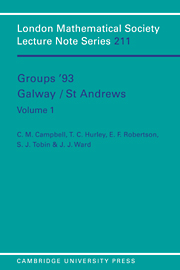Book contents
- Frontmatter
- Contents
- Preface
- Introduction
- Geometry, Steinberg representations and complexity
- The structure of metabelian finite groups
- Table algebras of extended Gagola-type and applications to finite group theory
- On the saturation of formations of finite groups
- Locally constructed formations of finite groups
- Reflections on virtually one-relator groups
- Rickard equivalences and block theory
- Computing the conjugacy classes of elements of a finite group
- Quotient categories of modules over group algebras
- Weak chain conditions for non-almost normal subgroups
- Computation of the character table of affine groups using Fischer matrices
- The lattice of compact representations of an infinite group
- Automorphisms of nilpotent and related groups
- Generation of orthogonal groups over finite fields
- The structure of certain Coxeter groups
- n-free groups and questions about universally free groups
- Classification of all generating pairs of two generator Fuchsian groups
- Parametric words and models of the elementary theory of non-abelian free groups
- The groups G(n, l) as fundamental groups of Seifert fibered homology spheres
- Lifting automorphisms: a survey
- (MI)-groups acting uniserially on a normal subgroup
- Revisiting a theorem of Higman
- Cohomological finiteness conditions
n-free groups and questions about universally free groups
Published online by Cambridge University Press: 02 March 2010
- Frontmatter
- Contents
- Preface
- Introduction
- Geometry, Steinberg representations and complexity
- The structure of metabelian finite groups
- Table algebras of extended Gagola-type and applications to finite group theory
- On the saturation of formations of finite groups
- Locally constructed formations of finite groups
- Reflections on virtually one-relator groups
- Rickard equivalences and block theory
- Computing the conjugacy classes of elements of a finite group
- Quotient categories of modules over group algebras
- Weak chain conditions for non-almost normal subgroups
- Computation of the character table of affine groups using Fischer matrices
- The lattice of compact representations of an infinite group
- Automorphisms of nilpotent and related groups
- Generation of orthogonal groups over finite fields
- The structure of certain Coxeter groups
- n-free groups and questions about universally free groups
- Classification of all generating pairs of two generator Fuchsian groups
- Parametric words and models of the elementary theory of non-abelian free groups
- The groups G(n, l) as fundamental groups of Seifert fibered homology spheres
- Lifting automorphisms: a survey
- (MI)-groups acting uniserially on a normal subgroup
- Revisiting a theorem of Higman
- Cohomological finiteness conditions
Summary
Abstract
This paper produces examples of groups which provide negative answers to earlier questions of Gaglione and Spellman. One such example is a consequence of some new results on constructing n-free groups which should also be of independent interest. Specifically, the primary focus is on answering: (1) Does there exist an integer r ≥ 3 such that every finitely-generated, nonabelian r-free group is a model of the elementary theory of the non-abelian free groups? In particular, does r = 3 satisfy this condition? and (2) Let G be a non-abelian group. Is it the case that G satisfies precisely the same universal sentences as the non- abelian free groups if and only if there is an ordered abelian group Λ and a Λ-tree T such that G acts via Λ-isometries on T freely and without inversions?
Introduction and preliminaries
For a positive integer n a group G is n-free if every subgroup generated by n or fewer distinct elements is free (necessarily if rank ≤ n).
G is locally free if it is n-free for all positive integers n; moreover, following Graham Higman [15], G is countably free if every countable subgroup is free. From straightforward topological considerations an orientable surface group of genus g is (2g – 1)-free. This was generalized by B. Baumslag [2] to show that certain cyclically pinched one relator groups are 2-free and extended by Rosenberger [19] to show that these groups are also 3-free (redone in a different manner by G. Baumslag and P. Shalen [4]).
- Type
- Chapter
- Information
- Groups '93 Galway/St Andrews , pp. 191 - 204Publisher: Cambridge University PressPrint publication year: 1995
- 5
- Cited by



